Alice Baird
DB3V: A Dialect Dominated Dataset of Bird Vocalisation for Cross-corpus Bird Species Recognition
Jun 11, 2024
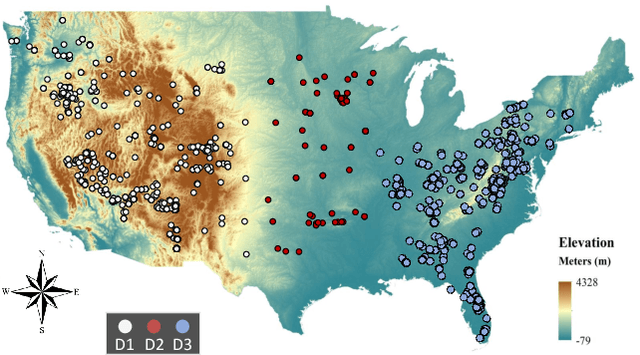
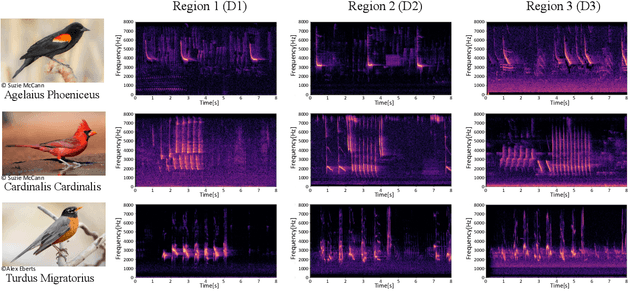

Abstract:In ornithology, bird species are known to have variedit's widely acknowledged that bird species display diverse dialects in their calls across different regions. Consequently, computational methods to identify bird species onsolely through their calls face critsignificalnt challenges. There is growing interest in understanding the impact of species-specific dialects on the effectiveness of bird species recognition methods. Despite potential mitigation through the expansion of dialect datasets, the absence of publicly available testing data currently impedes robust benchmarking efforts. This paper presents the Dialect Dominated Dataset of Bird Vocalisation, the first cross-corpus dataset that focuses on dialects in bird vocalisations. The DB3V comprises more than 25 hours of audio recordings from 10 bird species distributed across three distinct regions in the contiguous United States (CONUS). In addition to presenting the dataset, we conduct analyses and establish baseline models for cross-corpus bird recognition. The data and code are publicly available online: https://zenodo.org/records/11544734
The NeurIPS 2023 Machine Learning for Audio Workshop: Affective Audio Benchmarks and Novel Data
Mar 21, 2024



Abstract:The NeurIPS 2023 Machine Learning for Audio Workshop brings together machine learning (ML) experts from various audio domains. There are several valuable audio-driven ML tasks, from speech emotion recognition to audio event detection, but the community is sparse compared to other ML areas, e.g., computer vision or natural language processing. A major limitation with audio is the available data; with audio being a time-dependent modality, high-quality data collection is time-consuming and costly, making it challenging for academic groups to apply their often state-of-the-art strategies to a larger, more generalizable dataset. In this short white paper, to encourage researchers with limited access to large-datasets, the organizers first outline several open-source datasets that are available to the community, and for the duration of the workshop are making several propriety datasets available. Namely, three vocal datasets, Hume-Prosody, Hume-VocalBurst, an acted emotional speech dataset Modulate-Sonata, and an in-game streamer dataset Modulate-Stream. We outline the current baselines on these datasets but encourage researchers from across audio to utilize them outside of the initial baseline tasks.
The 6th Affective Behavior Analysis in-the-wild Competition
Mar 12, 2024Abstract:This paper describes the 6th Affective Behavior Analysis in-the-wild (ABAW) Competition, which is part of the respective Workshop held in conjunction with IEEE CVPR 2024. The 6th ABAW Competition addresses contemporary challenges in understanding human emotions and behaviors, crucial for the development of human-centered technologies. In more detail, the Competition focuses on affect related benchmarking tasks and comprises of five sub-challenges: i) Valence-Arousal Estimation (the target is to estimate two continuous affect dimensions, valence and arousal), ii) Expression Recognition (the target is to recognise between the mutually exclusive classes of the 7 basic expressions and 'other'), iii) Action Unit Detection (the target is to detect 12 action units), iv) Compound Expression Recognition (the target is to recognise between the 7 mutually exclusive compound expression classes), and v) Emotional Mimicry Intensity Estimation (the target is to estimate six continuous emotion dimensions). In the paper, we present these Challenges, describe their respective datasets and challenge protocols (we outline the evaluation metrics) and present the baseline systems as well as their obtained performance. More information for the Competition can be found in: https://affective-behavior-analysis-in-the-wild.github.io/6th.
The MuSe 2023 Multimodal Sentiment Analysis Challenge: Mimicked Emotions, Cross-Cultural Humour, and Personalisation
May 05, 2023



Abstract:The MuSe 2023 is a set of shared tasks addressing three different contemporary multimodal affect and sentiment analysis problems: In the Mimicked Emotions Sub-Challenge (MuSe-Mimic), participants predict three continuous emotion targets. This sub-challenge utilises the Hume-Vidmimic dataset comprising of user-generated videos. For the Cross-Cultural Humour Detection Sub-Challenge (MuSe-Humour), an extension of the Passau Spontaneous Football Coach Humour (Passau-SFCH) dataset is provided. Participants predict the presence of spontaneous humour in a cross-cultural setting. The Personalisation Sub-Challenge (MuSe-Personalisation) is based on the Ulm-Trier Social Stress Test (Ulm-TSST) dataset, featuring recordings of subjects in a stressed situation. Here, arousal and valence signals are to be predicted, whereas parts of the test labels are made available in order to facilitate personalisation. MuSe 2023 seeks to bring together a broad audience from different research communities such as audio-visual emotion recognition, natural language processing, signal processing, and health informatics. In this baseline paper, we introduce the datasets, sub-challenges, and provided feature sets. As a competitive baseline system, a Gated Recurrent Unit (GRU)-Recurrent Neural Network (RNN) is employed. On the respective sub-challenges' test datasets, it achieves a mean (across three continuous intensity targets) Pearson's Correlation Coefficient of .4727 for MuSe-Mimic, an Area Under the Curve (AUC) value of .8310 for MuSe-Humor and Concordance Correlation Coefficient (CCC) values of .7482 for arousal and .7827 for valence in the MuSe-Personalisation sub-challenge.
The ACM Multimedia 2023 Computational Paralinguistics Challenge: Emotion Share & Requests
May 01, 2023
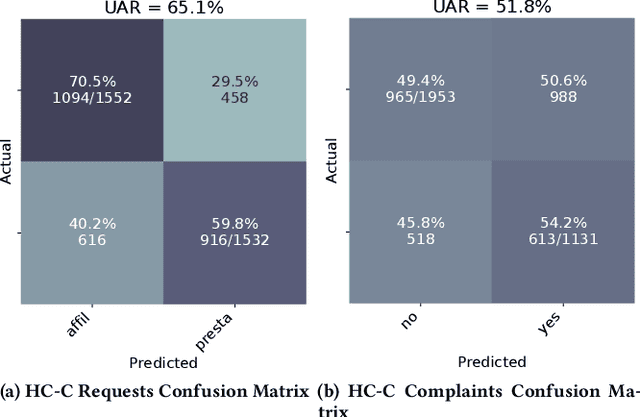

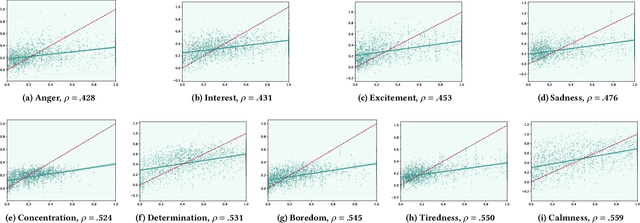
Abstract:The ACM Multimedia 2023 Computational Paralinguistics Challenge addresses two different problems for the first time in a research competition under well-defined conditions: In the Emotion Share Sub-Challenge, a regression on speech has to be made; and in the Requests Sub-Challenges, requests and complaints need to be detected. We describe the Sub-Challenges, baseline feature extraction, and classifiers based on the usual ComPaRE features, the auDeep toolkit, and deep feature extraction from pre-trained CNNs using the DeepSpectRum toolkit; in addition, wav2vec2 models are used.
ABAW: Valence-Arousal Estimation, Expression Recognition, Action Unit Detection & Emotional Reaction Intensity Estimation Challenges
Mar 20, 2023



Abstract:The fifth Affective Behavior Analysis in-the-wild (ABAW) Competition is part of the respective ABAW Workshop which will be held in conjunction with IEEE Computer Vision and Pattern Recognition Conference (CVPR), 2023. The 5th ABAW Competition is a continuation of the Competitions held at ECCV 2022, IEEE CVPR 2022, ICCV 2021, IEEE FG 2020 and CVPR 2017 Conferences, and is dedicated at automatically analyzing affect. For this year's Competition, we feature two corpora: i) an extended version of the Aff-Wild2 database and ii) the Hume-Reaction dataset. The former database is an audiovisual one of around 600 videos of around 3M frames and is annotated with respect to:a) two continuous affect dimensions -valence (how positive/negative a person is) and arousal (how active/passive a person is)-; b) basic expressions (e.g. happiness, sadness, neutral state); and c) atomic facial muscle actions (i.e., action units). The latter dataset is an audiovisual one in which reactions of individuals to emotional stimuli have been annotated with respect to seven emotional expression intensities. Thus the 5th ABAW Competition encompasses four Challenges: i) uni-task Valence-Arousal Estimation, ii) uni-task Expression Classification, iii) uni-task Action Unit Detection, and iv) Emotional Reaction Intensity Estimation. In this paper, we present these Challenges, along with their corpora, we outline the evaluation metrics, we present the baseline systems and illustrate their obtained performance.
HEAR4Health: A blueprint for making computer audition a staple of modern healthcare
Jan 25, 2023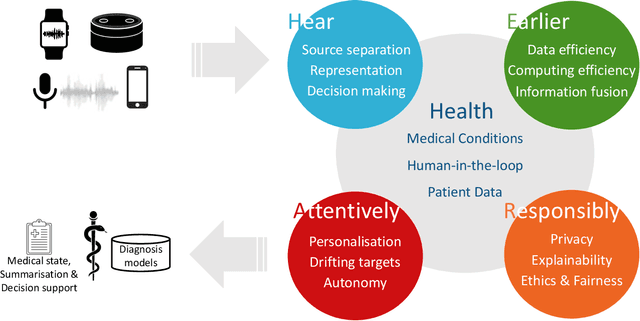

Abstract:Recent years have seen a rapid increase in digital medicine research in an attempt to transform traditional healthcare systems to their modern, intelligent, and versatile equivalents that are adequately equipped to tackle contemporary challenges. This has led to a wave of applications that utilise AI technologies; first and foremost in the fields of medical imaging, but also in the use of wearables and other intelligent sensors. In comparison, computer audition can be seen to be lagging behind, at least in terms of commercial interest. Yet, audition has long been a staple assistant for medical practitioners, with the stethoscope being the quintessential sign of doctors around the world. Transforming this traditional technology with the use of AI entails a set of unique challenges. We categorise the advances needed in four key pillars: Hear, corresponding to the cornerstone technologies needed to analyse auditory signals in real-life conditions; Earlier, for the advances needed in computational and data efficiency; Attentively, for accounting to individual differences and handling the longitudinal nature of medical data; and, finally, Responsibly, for ensuring compliance to the ethical standards accorded to the field of medicine.
Proceedings of the ACII Affective Vocal Bursts Workshop and Competition 2022 (A-VB): Understanding a critically understudied modality of emotional expression
Oct 27, 2022Abstract:This is the Proceedings of the ACII Affective Vocal Bursts Workshop and Competition (A-VB). A-VB was a workshop-based challenge that introduces the problem of understanding emotional expression in vocal bursts -- a wide range of non-verbal vocalizations that includes laughs, grunts, gasps, and much more. With affective states informing both mental and physical wellbeing, the core focus of the A-VB workshop was the broader discussion of current strategies in affective computing for modeling vocal emotional expression. Within this first iteration of the A-VB challenge, the participants were presented with four emotion-focused sub-challenges that utilize the large-scale and `in-the-wild' Hume-VB dataset. The dataset and the four sub-challenges draw attention to new innovations in emotion science as it pertains to vocal expression, addressing low- and high-dimensional theories of emotional expression, cultural variation, and `call types' (laugh, cry, sigh, etc.).
Proceedings of the ICML 2022 Expressive Vocalizations Workshop and Competition: Recognizing, Generating, and Personalizing Vocal Bursts
Jul 14, 2022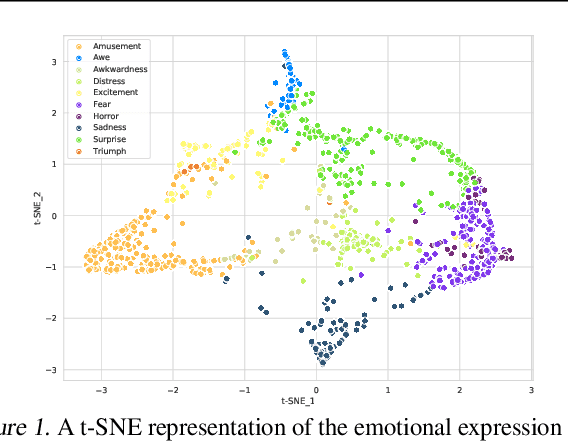
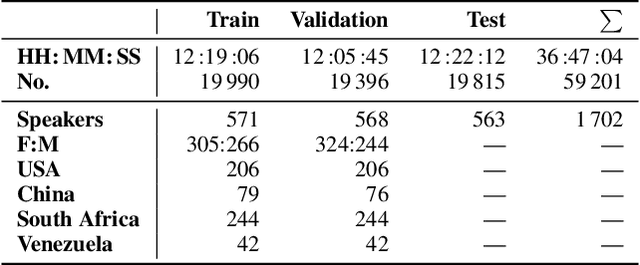

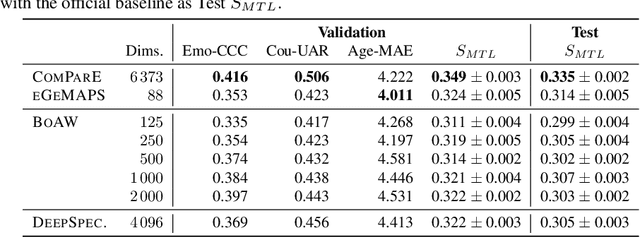
Abstract:This is the Proceedings of the ICML Expressive Vocalization (ExVo) Competition. The ExVo competition focuses on understanding and generating vocal bursts: laughs, gasps, cries, and other non-verbal vocalizations that are central to emotional expression and communication. ExVo 2022, included three competition tracks using a large-scale dataset of 59,201 vocalizations from 1,702 speakers. The first, ExVo-MultiTask, requires participants to train a multi-task model to recognize expressed emotions and demographic traits from vocal bursts. The second, ExVo-Generate, requires participants to train a generative model that produces vocal bursts conveying ten different emotions. The third, ExVo-FewShot, requires participants to leverage few-shot learning incorporating speaker identity to train a model for the recognition of 10 emotions conveyed by vocal bursts.
The ACII 2022 Affective Vocal Bursts Workshop & Competition: Understanding a critically understudied modality of emotional expression
Jul 07, 2022
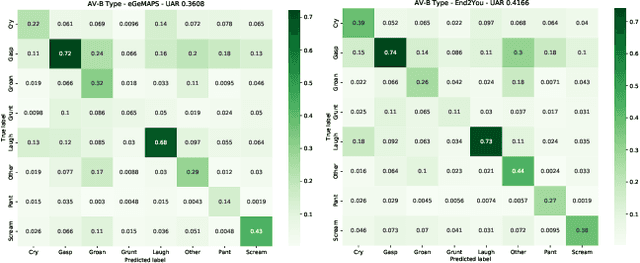
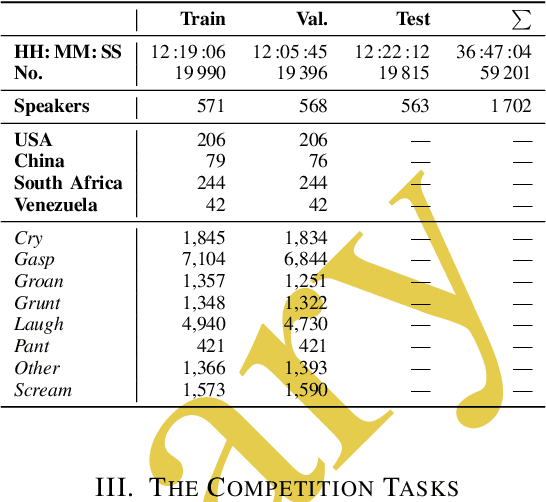
Abstract:The ACII Affective Vocal Bursts Workshop & Competition is focused on understanding multiple affective dimensions of vocal bursts: laughs, gasps, cries, screams, and many other non-linguistic vocalizations central to the expression of emotion and to human communication more generally. This year's competition comprises four tracks using a large-scale and in-the-wild dataset of 59,299 vocalizations from 1,702 speakers. The first, the A-VB-High task, requires competition participants to perform a multi-label regression on a novel model for emotion, utilizing ten classes of richly annotated emotional expression intensities, including; Awe, Fear, and Surprise. The second, the A-VB-Two task, utilizes the more conventional 2-dimensional model for emotion, arousal, and valence. The third, the A-VB-Culture task, requires participants to explore the cultural aspects of the dataset, training native-country dependent models. Finally, for the fourth task, A-VB-Type, participants should recognize the type of vocal burst (e.g., laughter, cry, grunt) as an 8-class classification. This paper describes the four tracks and baseline systems, which use state-of-the-art machine learning methods. The baseline performance for each track is obtained by utilizing an end-to-end deep learning model and is as follows: for A-VB-High, a mean (over the 10-dimensions) Concordance Correlation Coefficient (CCC) of 0.5687 CCC is obtained; for A-VB-Two, a mean (over the 2-dimensions) CCC of 0.5084 is obtained; for A-VB-Culture, a mean CCC from the four cultures of 0.4401 is obtained; and for A-VB-Type, the baseline Unweighted Average Recall (UAR) from the 8-classes is 0.4172 UAR.
 Add to Chrome
Add to Chrome Add to Firefox
Add to Firefox Add to Edge
Add to Edge